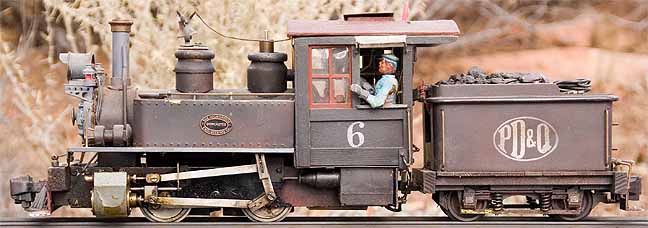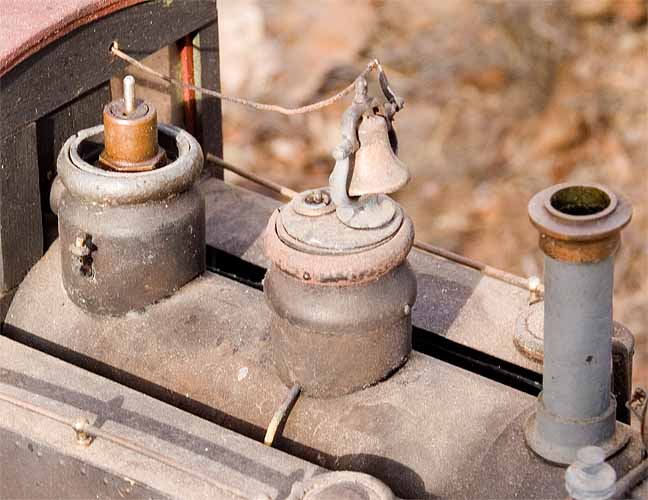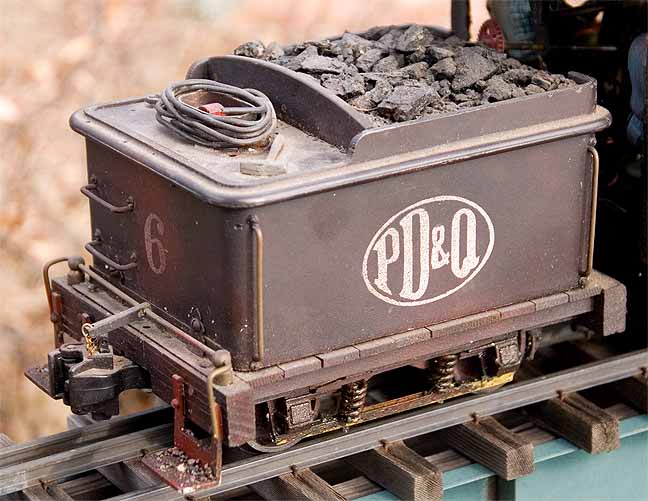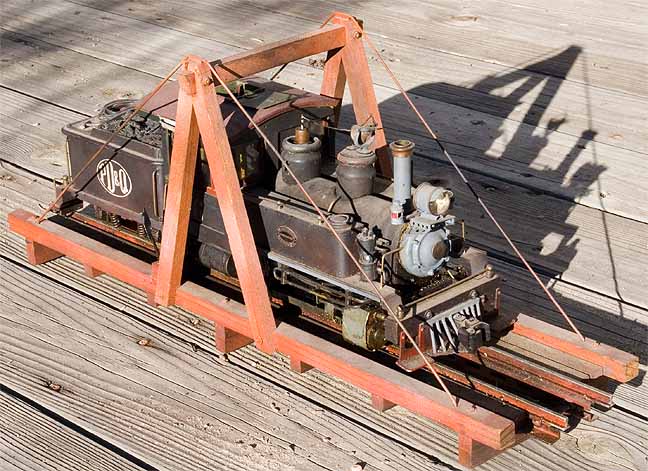
Back to Loco of the Month homepage
Back to Sidestreet Bannerworks
.
January 2009
Dutton Foster's Americanized "Pooter"
by Marc Horovitz

This interesting and charming locomotive started life as a Roundhouse "Pooter." (You can read the story of the "Pooters" by clicking here.) It's an 0-4-0 tank engine with Hackworth valve gear and a pot boiler fired by alcohol. Its original styling was decidedly British. The boiler is fitted with a pressure gauge (defunct), a throttle, a safety valve, and a blowdown.
Dutton Foster is a garden railroader in Minnesota, whose well-known Paradox, Dilemma, and Quandary Railroad has appeared in the pages of Garden Railways magazine off and on over the past 20+ years. The locomotive under examination today was first mentioned in the May-June 1986 issue of GR. When first acquired, Dutton found that it tended to fall between the rails of his handlaid track, partly due to the track and partly due to the fact that the drivers had narrower treads than LGB stock. Once that situation was remedied by the track crew, modifications commenced.
The theater is part of Dutton's background, and his conversion was approached in a somewhat theatrical way. This is not a finescale conversion by any means, but it is a highly effective one. The original body was replaced by a new one made of brass, wood, and aluminum. A new "boiler tube" pilot was made (see drawing below), as was a new cab made of stripwood that Dutton cut up on his table saw. The cab roof is made of planks, covered in muslin stretched over wet enamel for waterproofing. The hatch in the top opens. A variety of other details were added to the engine, including a sand dome made of copper tubing, held in place by the sand pipes, which engage the engine's heat shields. The original Roundhouse builder's plates were reinstalled on the tank sides.
The tender was made of a plastic food container that sits on a scratchbuilt wooden frame, which, in turn, sits on an "expanded" LGB truck.
The locomotive was originally radio controlled. Dutton installed an engineer and fireman, with various parts amputated as necessary so they'd fit. R/C didn't work out so well -- too much glitching -- so the radio was eventually removed and the engine converted to manual control. Extensions were added to the reversing lever and throttle, making them accessible from the cab roof, under the hatch. The fuel-filler pipe was also extended up to that space. An extension was fitted to the blower valve, bringing it out to the back of the cab for convenience.
Old No. 6, as the engine was now known, was painted with spray bombs, mostly red-oxide primer and flat black, high-heat enamel. The cab-side number and the railroad's herald on the tender were cut out of gummed label paper, then stuck to their respective surfaces, which had previously been painted white. They were then painted black and the paper was removed, revealing the white lettering beneath.
To both display and transport the engine, Dutton came up with the solution of building a gallows, similar to that of a turntable, complete with track. The top crosspiece of this wooden structure acts as a handle. To prevent the locomotive from rolling off at inopportune moments, an ingenious latching device was employed (see photos below). In one position, it trapped the engine in place; in the other position, the engine was free to move.
The run
Run day on the Ogden Botanical Railway was cold and blustery. This engine had run many miles on the PD&Q since it was first shown over 20 years ago, and it definitely showed signs of use. I prepared it in the usual way, then lit the fire. The pressure gauge had given up the ghost back in the mists of time somewhere, so was out of the running.
After a reasonable amount of time, pressure came up. I opened the throttle, using the lever protruding throuhg the cab roof. Steam immediately condensed in the cylinders, requiring me to push the engine to clear the condensate. Once that was done, the engine took off. I found that it ran better in reverse than forward (forward being a little lumpy), suggesting that perhaps some linkage adjustment might be in order. In reverse it ran sweetly.
The run lasted 20 minutes or so. It would have gone on longer, but I was getting too cold and the fun was seeping away with the heat. A successful run was pronounced and the fire dropped. No. 6 was retired to the workshop for a little necessary maintenance. It was great seeing this relic of the venerable PD&Q resurrected on the OBR.
|
|
|
| Builder | Roundhouse Engineering -- modified by Dutton Foster |
| Date built | 1986 |
| Gauge | 45 mm |
| Scale | 16mm originally -- converted to 1:20.3 |
| Boiler | Pot |
| Fittings | Safety valve, pressure gauge, throttle, blowdown valve |
| Fuel | Alcohol |
| Blow-off pressure | 45 psi |
| Cylinders | Two, double-acting D-valve |
| Reversing gear | Hackworth gear |
| Lubricator | Displacement |
| Weight | 6 lb., 4 oz. (loco and tender) |
| Dimensions | Length, 17-3/4" (loco and tender); width, 4-1/2"; height, 6-1/8" |














Back to Loco of the Month home page
Back to Sidestreet Bannerworks home page
This page and its contents
Copyright Sidestreet Bannerworks, 2008
.